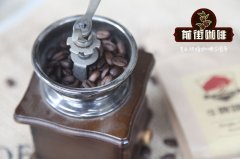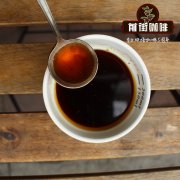How do you drink coffee from Santa Ferrisa Manor in the Accatel Nan Fruit region, Guatemala?

Professional coffee knowledge exchange more coffee bean information please follow the coffee workshop (Wechat official account cafe_style)
Santa Felisa and Orange Honey
Kaduai is a hybrid of bourbon and Tibica, and the bean body is slightly larger than the original bourbon.
Let's start with honey treatment.
Honey treatment is to mechanically remove part of the pulp of the coffee cherry and then ferment it in the sun.
Unlike the sun, because the flesh is cut, the bacteria can go directly inside to ferment, and the whole coffee shelf will become sticky and give off a sweet smell.
According to the amount of pulp left, honey treatment can be roughly divided into black honey, red honey, yellow honey and white honey. The more left the flesh is, the more pulp is left.
Since fermentation is difficult to control, it is often necessary to flip to ensure that there is no excessive fermentation.
After reading the above instructions, you will be the same as when the young boss saw Li Yan's fried shrimp and asked, "so I said, where's the orange?"
Orange honey is, in the choice of coffee cherries, first choose coffee cherries with a sweetness of more than 21 degrees, and before honey treatment, put coffee cherries in water for 24 hours and then carry out general honey treatment, because the color is lighter, so it is called orange honey, so the sweetness will be very high!
This treatment is unique to Santa Ferrisa Manor.
In 1904, Mr.Trinidad E. Cruz founded Saint Felicia Manor in Acatenango, one of the well-known producing areas of Guatemala. So far, the manor has entered the fourth generation of operation (currently by Anabella and Antonio Meneses. Brother and sister management). Arcatel Nanguo belongs to Chimaltenango province, Antigua to the east and Atitlan to the west. The coffee planting area surrounds the Arcatel Nanguo Valley (Acatenango Valley) with an average elevation of 1300-2300 and is surrounded by two volcanoes, such as Volcan Acatenango and Volcan de Fuego. It can be expected that the whole coffee planting area is nourished by volcanic fertile soil. Saint Felicia is located at an altitude of 1500-1920m, with an annual precipitation of 1200-1500mm and an average temperature of 17.7-22.7C. Suitable micro-climatic conditions are more conducive to the slow ripening of coffee and absorb enough nutrients.
In addition to the orange honey treatment, we also sold the K72 washing treatment of this manor last year.
K72 is derived from Kenyan water washing. Ripe cherries are harvested and fermented for up to 72 hours and washed every 24 hours to avoid over-fermentation.
In 2011, St. Felicia Manor began its own independent bidding campaign. The highest-priced batch this year is the African Geisha species of the estate's double fermentation (Double Soak) (the estate also has a Panamanian Geisha2722 species). Double fermentation is similar to KMel 72, except that the whole fermentation is only twice, and the time is only about 40 hours.
Important Notice :
前街咖啡 FrontStreet Coffee has moved to new addredd:
FrontStreet Coffee Address: 315,Donghua East Road,GuangZhou
Tel:020 38364473
- Prev

The Coffee Association of Guatemala vigorously promotes the characteristics of coffee in the new producing area of Akanan Fruit to SCAA.
Professional coffee knowledge exchange more coffee bean information please follow the coffee workshop (Wechat official account cafe_style) Guatemala Acatenango La Cascada Guatemala Coffee Association to promote the new producing areas to SCAA! La Cascada comes from the Acatenango Valley, a very unique coffee region in Guatemala.
- Next

What are the flavor characteristics of coffee beans in the Koban rainforest region of Guatemala? How do you classify the grades?
What are the flavor characteristics of coffee beans in the Koban rainforest region of Guatemala? How do you classify the grades? The coffee beans produced in Guatemala, which has seven major coffee producing areas, are all Arabica, all located on the highland topography of the subtropical climate, with rich and stable rainfall and fertile volcanic ash soil. as a result, all parts of the country have natural environmental conditions that are very suitable for coffee cultivation. Each producing area has a unique flavor.
Related
- Detailed explanation of Jadeite planting Land in Panamanian Jadeite Manor introduction to the grading system of Jadeite competitive bidding, Red bid, Green bid and Rose Summer
- Story of Coffee planting in Brenka region of Costa Rica Stonehenge Manor anaerobic heavy honey treatment of flavor mouth
- What's on the barrel of Blue Mountain Coffee beans?
- Can American coffee also pull flowers? How to use hot American style to pull out a good-looking pattern?
- Can you make a cold extract with coffee beans? What is the right proportion for cold-extracted coffee formula?
- Indonesian PWN Gold Mandrine Coffee Origin Features Flavor How to Chong? Mandolin coffee is American.
- A brief introduction to the flavor characteristics of Brazilian yellow bourbon coffee beans
- What is the effect of different water quality on the flavor of cold-extracted coffee? What kind of water is best for brewing coffee?
- Why do you think of Rose Summer whenever you mention Panamanian coffee?
- Introduction to the characteristics of authentic blue mountain coffee bean producing areas? What is the CIB Coffee Authority in Jamaica?

